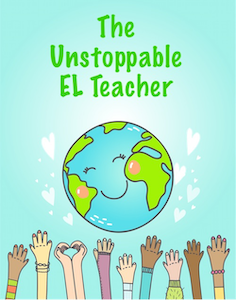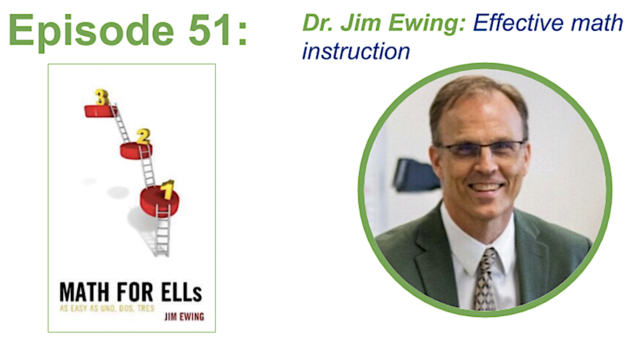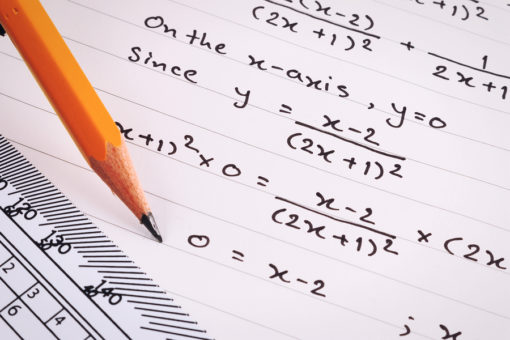Help Language Learners Overcome 3 Math Myths
A MiddleWeb Blog

When students went to math class, though, I did not follow them. That doesn’t mean my students were all able to access the math content and didn’t need my help – just that we had limited personnel.
The myths around math instruction and language learners are pervasive. Dr. Jim Ewing believes there are three myths that often hold language learners back from high levels of achievement in math class.
Jim Ewing discusses those three myths in a recent conversation at my Empowering LLs podcast. You can listen here. I’ve summarized his key ideas here.
The 3 Math Myths
Myth 1: Math does not involve language
This is a big misconception. Math is not just numbers and shapes. It has its own set of content-specific vocabulary (e.g., fractions, divided, sum, factor, multiple, etc.). If students don’t know the English math words, it is much more challenging to follow along.
Myth 2: Teachers should have low expectations of language learners in math
Some language learners are held to lower expectations while learning math because of their developing English proficiency. However, these students are often capable of engaging in highly challenging mathematical computations. Language ability does not equal mathematical level or ability. Many language learners can compute and problem solve at a much higher level than their English proficiency would suggest.
Myth 3: Good mathematicians are fast
It can take a significant amount of time to solve a complex problem. Mathematicians need to be meticulous and persistent when faced with a tough question. Processing speed does not equal skill mastery. Moreover, students who must translate instructions and directions are almost always going to need a little more time to show their skill growth.
A Framework for Success
In Ewing’s book, Maths for ELLs: As easy as uno, does, tres, he offers a framework to support teachers as they help students master math concepts and processes. The framework encourages teachers to remember these four components :
Mindset
Create positive learning experiences that respect students and their cultures. They need to see themselves, their experiences, their neighborhoods, their customs, and their ways of being in math. When this happens regularly, students will believe that math is both a part of their cultures and accessible. One way to accomplish this is to add a culture objective to your next lesson or unit.
Access
Use strategies (labeled diagrams, video tutorials, manipulatives, translanguaging, sentence starters) to establish comprehensible input and scaffold for comprehensible output.
Teach (Language)
Explicitly teach the math-specific vocabulary and phrases (more than, less than, divided by, a multiple of, etc.) so that students can comprehend instruction and communicate their thinking mathematically. This also means teaching through student-to-student discussion because talking about the math problems helps students develop math skills and concepts. Talking is an act of creating, and creating is the fruit of learning. Teach content-specific language using these ideas.
Struggle
Make sure to structure learning experiences to be appropriately challenging while still providing scaffolds for students to engage in the rigorous mathematical concepts and processes. In other words, if you want to test them on the content, don’t test them on the language.
A Model for Math Instruction
When I asked Ewing for specific strategies that support language learners, he offered a 5E model to structure math lessons to boost student achievement levels.
Engage
Hook the students into being interested in engaging with the math problem. If possible, create a real-life context for students that requires specific mathematical processes. For example, you can set the math problem at a quinceañera and create a math problem with characters and events connected to this party.
Explore
Structure math less as a set of formulas to follow and more as an inquiry into ways to solve the problem. This would stimulate greater critical thinking. For example, you can ask students to determine how many packs of paper plates the family hosting the quinceañera party needs if they have 50 guests, each guest will use two plates, and the paper plates come in packs of 9.
Explain
Have students explain the process they took to solve the problem about the quinceañera party. They can do so either by talking to each other or through writing. This conversation solidifies their understanding of the math concepts and encourages the use of math terminology and phrases to communicate. Students can use their home languages as they discuss the math problem too.
Extend
Take a concept students just learned and add another concept to build on their understanding. For example, students can add packs of paper plates until they reach 100 plates for the quinceañera party. To extend students’ math skills, teach them how to multiply as another process to solve this problem.
Evaluate
Ensure that students can comprehend the task and the questions before evaluating their understanding. Also, make sure that students comprehend math-specific terms that will appear on the assessment and that they can use the terms accurately.
For math class and beyond
I hope that these suggestions have affirmed much of what you are already doing with your students and that you can add a few more tools to your tool box when it comes to designing instruction for language learners. Though these suggestions are for learning math, they can guide designing instruction in all content areas because they are based on equity, access, and relevance.
How will you use these ideas to structure your math lessons to ensure that language learners are successful?






































